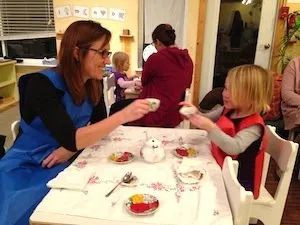Observations of the Montessori Prepared Environment
I recently had the pleasure of visiting a local Montessori classroom while on a tour with the director of the school. This particular school is for children as young as two months and continues through eighth grade. As it is currently summer session, the older children were on school break during my visit, but classes were in session for children under six years of age.
I have heard many people express their amazement over the peaceful and orderly nature of the Montessori classroom, and I felt just the same. It really is amazing to stand among a group of twenty or so very young children and watch them work…calmly, with remarkable focus and determination. True, my children attended Montessori school when they were younger so I have witnessed this wonder before, but that doesn’t make it any less impressive. As I watched the children and spoke with the director, I learned some interesting basics about the prepared environment of the Montessori classroom, which I’d like to share with you here…

- The work must be beautiful. I noticed one child doing a practical-life, pouring activity with real (and very pretty) porcelain teapot, cups, and saucers. I couldn’t help but wonder; wouldn’t it be more cost effective to use an indestructible, plastic tea serving set? The director explained that it is often the beauty of the materials that attracts the children to the activity in the first place. He also explained that by using real materials, the children are more inclined to take care of them.
- The work should have a real-life application. It was obvious from the first glance, that many of the learning activities in the classroom had real-life purpose. I saw children spooning, sorting with tweezers, pouring, buttoning, tying, and sweeping. These were clearly important, independent-life skills and the children were developing essential fine and gross motor skills. The director explained that children are far more attracted to activities which they have seen in their day to day lives.
- The work must have a control of error. The Montessori Method teaches through example and hands on application, not through correcting. How then, do the children learn to do the work correctly? Many activities have a “natural” control of error. For example, if a child is doing a pouring exercise and spills the water, he can easily see his error. No problem; he simply cleans the spill and tries again. There is never any need for the teacher to step in and the child continues to be self-motivated. Other activities include a way for the child to check their own work, such as a color code for matching cards, or a master key for shelf work. As the director explained, if the child has to ask a teacher to check his work, there is no control of error.
- The work should be active. I watched as one child worked with a map lesson. She had a puzzle of the continents and I assumed she would simply put the puzzle pieces into place. Instead, she traced one of the continents on a piece of brightly colored construction paper she selected herself. Next, she took a hole-puncher and carefully cut out the shape of the continent with dozens of little holes. Finally, she glued the continent onto a piece of beautiful, ocean blue paper. This process took quite a while, and the child never even looked up from her task. She was that engrossed in her lesson. By working actively instead of passively, she had thoroughly enjoyed teaching herself the shape of the continent. She was still working away at it when it was time for me to go.
If you are curious about any of the concepts that I have described here, or if you just want to witness the magic of the Montessori Method yourself, I encourage you to visit a local Montessori school near you. For more information about the Montessori Method or the prepared environment, I invite you to visit Age of Montessori’s information rich website and learn from the many resources available to you there!






















